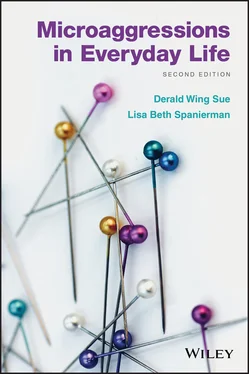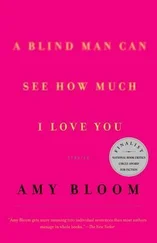
Figure 2.1 Categories of and Associations among Microaggressions. Reproduced with permission of Sue, D. W. et al. (2007).
Verbal microassaults include the use of racial epithets: referring to African Americans as “n*****s,” Chinese Americans as “chinks,” Japanese Americans as “Japs,” Native Americans as “savages,” women as “bitches” or “cunts,” and gay men as “fags.” Again, the intent is to assail people’s racial, social‐group identity and to communicate to recipients that they are lesser human beings. Telling ethnic, racial, gender, or sexual‐orientation jokes and laughing at them also might fall into this category. With respect to behavior, forbidding a son or daughter from marrying outside of one's race, ignoring a group of women who are requesting a table at a restaurant, and promoting a less‐qualified heterosexual employee over a gay one are additional examples of intent to harm or exclude. Again, such actions communicate to recipients that they are unworthy to be served and/or that they are not the right kind of people and do not belong.
Microassaults are most similar to what has been called old‐fashioned racism, sexism, or heterosexism perpetrated on an individual level. They are likely to be conscious and deliberate acts. However, because of strong public condemnation of such behaviors, microassaults are most likely to be expressed under three conditions that afford the perpetrator some form of protection (D. W. Sue & Capodilupo, 2008).
First, when perpetrators feel some degree of anonymity and are assured that their roles or actions can be concealed, they may feel freer to engage in microassaults (scrawling anti‐Semitic graffiti in public restrooms, posting anonymous epithets against Muslims on the web, or hanging a noose surreptitiously on the door of a Black colleague).
Second, consistent with research by Bursztyn et al. (2017), perpetrators may engage in a microassault when they feel relatively safe, such as being in the presence of people who share their beliefs and attitudes or knowing that they can get away with their offensive words and deeds. Safety often relies on the inaction of others in the face of biased actions. In fact, studies reveal that people often overpredict whether they would take action against a biased action (hearing a racist comment). While they may condemn and say they would take appropriate action, when faced with the real situation they remain silent or inactive (Kawakami, Dunn, Karmali, & Dovidio, 2009). Example 2.5is representative of this condition.
Third, many people who privately hold notions of minority inferiority will display their biased attitudes only when they lose control. The opening examples in this chapter, especially that of Rosanne Barr, demonstrate this third condition of losing control. According to Barr, she was taking a sedative, Ambien, which resulted in her being an “idiot.” It is also possible that she was less controlled on this sedative and thus she was unable to censor her racist assumptions.
Microassaults are most similar to “old‐fashioned” racism: They are the type the public generally associates with “true racism”: direct, deliberate, obvious, and explicit. The key to understanding microassaults is that there is no guesswork involved in their intent, which is to harm, humiliate, or degrade people of color, women, and LGBTQ individuals.
At a fraternity sports party, a group of White fraternity brothers were sitting around their living room during a late Sunday afternoon, chugging down beer after beer tapped from a keg. They had just finished watching the first half of a football game and were obviously quite inebriated. Excitedly talking about the last play from scrimmage that resulted in an incomplete pass, one of the guys exclaimed, “Them n*****s can't play quarterback!” This brought out a howl of laughter, and another member said, “That's because they're just jungle bunnies!” More laughter erupted in the room and others produced a flurry of racial slurs: “monkey,” “coon,” “burr head,” “oreo,” and “Uncle Tom!” Each slur brought on laughter and renewed attempts to outdo one another in finding the most degrading reference to Blacks. As they exhausted their list, the game became a form of free association with blackness. “Black pussy, black sheep, criminal, rapist, castration, welfare family, cattle prod,” and so on, they shouted. It was clear that some of those in the group were quite uncomfortable with the game, but said nothing and chuckled at the responses anyway.
(D. W. Sue, 2003, p. 88)
In many respects, members of marginalized groups find it easier to deal with microassaults or blatant racism because the intent is clear and the recipients of such abuse do not have to expend psychological energy on ambiguity. In fact, there are indications that people of color are better prepared to deal with overt microassaults (Salvatore & Shelton, 2007) than unintentional biased behavior that resides outside the level of awareness of perpetrators—microinsults and microinvalidations. Empirical research has supported this assertion, showing that Black and Latinx participants experienced greater cognitive depletion from a confederate's subtle racism compared to overt racism (Murphy, Richeson, Shelton, Rheinschmidt, & Bergsieker, 2012). Thus, subtle, invisible, and unintentional forms of microaggressions are the main subject of this book. Table 2.1provides examples of common microaggression themes with examples and their hidden demeaning messages directed toward people of color, women, and LGBTQ persons.
Table 2.1 Examples of Racial, Gender, and Sexual‐Orientation Microaggressions
Source: Adapted from D. W. Sue and Capodilupo (2008, pp. 114–117).
| THEMES |
MICROAGGRESSION |
MESSAGE |
| Alien in One's Own LandAsian Americans and Latinx Americans are assumed to be foreign‐born |
“Where are you from?”“Where were you born?” “You speak English very well.” |
You are not American. |
| A person asks an Asian American to teach them words in their native language. |
You are a foreigner. |
| Ascription of IntelligenceAssigning intelligence to a person of color or woman based on their social‐group identity |
“You are a credit to your race.” |
People of color are generally not as intelligent as Whites. |
| “Wow! How did you become so good in math?” |
It is unusual for a woman to be smart in math. |
| Asking an Asian person to help with a math or science problem. |
All Asians are intelligent and good in math and sciences. |
| Color‐BlindnessStatements that indicate that a White person does not want to acknowledge race |
“When I look at you, I don't see color.” |
Denying a person of color's racial/ethnic experiences. |
| “America is a melting pot.” |
Assimilate/acculturate to dominant culture. |
| “There is only one race, the human race.” |
Denying the individual as a racial/cultural being. |
| Criminality/Assumption of Criminal StatusPerson of color is presumed dangerous, criminal, or deviant based on race |
A White man or woman clutches their purse or checks their wallet as a Black or Latinx American approaches or passes. |
You are a criminal. |
| A store owner follows a customer of color around the store. |
You are going to steal/You are poor/You do not belong. |
| A White person waits to ride the next elevator when a person of color is on it. |
You are dangerous. |
| Use of Sexist/ Heterosexist LanguageTerms that exclude or degrade women and LGBTQ persons |
Use of the pronoun “he” to refer to all people. Checkboxes on a form (male or female to specify one’s gender). |
Male experience is universal. Female experience is meaningless. Gender is binary. You must fit into one or the other. |
| An assertive woman is labeled a “bitch.” |
Women should be passive. |
| A heterosexual man who often hangs out with female friends more than male friends is labeled a “faggot.” |
Men who act like women are inferior (women are inferior)/gay men are inferior. |
| Denial of Individual Racism/Sexism/Genderism/HeterosexismStatement that denies one’s personal bias |
“I'm not racist. I have several Black friends.” |
I am immune to racism because I have friends of color. |
| “As an employer, I always treat men and women equally.” |
I am incapable of sexism. |
| Myth of MeritocracyStatements asserting that race or gender does not play a role in life successes |
“I believe the most qualified person should get the job.” |
People of color are given extra unfair benefits because of their race. |
| “Men and women have equal opportunities for achievement.” |
The playing field is even so if women cannot make it, the problem is with them. |
| Pathologizing Cultural Values/Communication StylesNotion that values and communication styles of dominant/White culture are ideal |
Asking a Black person: “Why do you have to be so loud/animated?” “Just calm down.” |
Assimilate to the dominant culture. |
| To an Asian or Latinx person: “Why are you so quiet? We want to know what you think. Be more verbal.” “Speak up more.” |
Something is wrong with you. |
| Dismissing an individual who brings up race/culture in work/school setting. |
Leave your cultural baggage outside. |
| Second‐Class CitizenWhen target group member receives differential treatment from power group |
Person of color is mistaken for a service worker. |
People of color are servants to Whites. |
| Female doctor is mistaken for a nurse. |
Women occupy nurturing roles and couldn’t possibly be physicians. |
| Having a taxi pass a person of color and pick up a White passenger. Being ignored at a store counter as attention is given to the White customer behind a person of color. |
You are likely to cause trouble and/or travel to a dangerous neighborhood. Whites are more valued customers than people of color. |
| A lesbian woman is not invited out with a group of girlfriends because they thought she would be bored if they were talking to men. |
You don't belong. |
| Traditional Gender Role Prejudicing and StereotypingExpectations of traditional roles or stereotypes are conveyed |
When a female student asked a male professor for extra help on a chemistry assignment, he asks, “What do you need to work on this for anyway?” |
Women are less capable in math and science. |
| A person asks a woman her age and, upon hearing she is 31, looks quickly at her ring finger. |
Women should be married during child‐bearing ages because that is their primary purpose. |
| A woman is assumed to be a lesbian because she does not put a lot of effort into her appearance. |
Lesbians do not care about being attractive to others. |
| Sexual ObjectificationWomen are treated as if they are objects at men's disposal |
A male stranger puts his hands on a woman's hips or on the small of her back to pass by her. |
Your body is not yours. |
| Whistles and catcalls as a woman walks down the street. |
Your body/appearance is for men's enjoyment and pleasure. |
| Assumption of AbnormalityImplication that there is something wrong with being LGBTQ |
Two men holding hands in public are stared at by strangers. |
You should keep your displays of affection private because they are offensive. |
| Students use the term “gay” to describe a fellow student who is socially ostracized at school. A trans woman is asked in a dorm elevator, “Are you a boy or a girl?” |
People who are gay are weird and different. People must fit into one category in a male‐female gender binary. |
Many microaggressions are common across various marginalized groups, but there are differences in types, hidden messages, and impact. Manifestation of microaggressions is contingent upon context and conventional stereotypes that are supported in those contexts. For instance, women may experience a unique microaggression such as “sexual objectification” that is not present for heterosexual men, regardless of racial‐group membership. And there are distinctions within categories. In other words, racial microaggressions are not experienced in the same way by individuals across racial groups. In the United States, for example, Asian Americans and Latinx individuals are more likely to experience “alien in one's own land” messages than are African Americans, who are more likely to be seen as “criminals.” Please note that we elaborate on similarities and differences in microaggressive manifestations across group and context in Chapter 7, where we also address cutting‐edge research on the intersectional nature of microaggressions (within‐group differences).
Читать дальше













